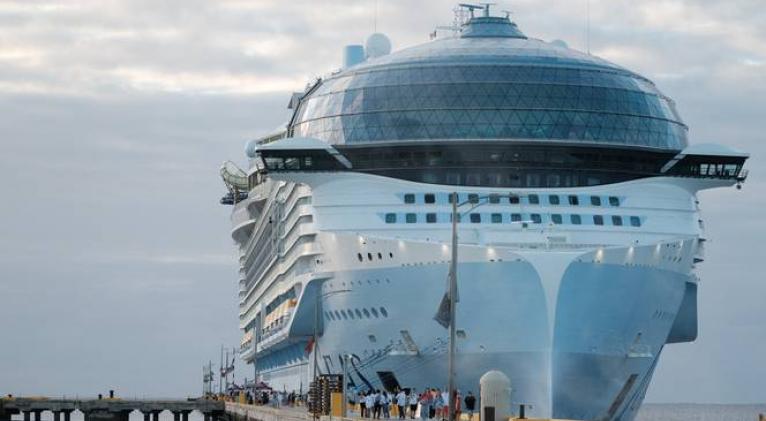The luxury cruise you took added to the global climate crisis. Here's how
especiales

It’s one thing to act like a climate-conscious holiday-maker who uses a paper straw to enjoy a summer drink at a faraway, pristine beach to save it from climate change.
But such feel-good measures amount to little more than a drop in the bucket in the bigger fight for the long-term health of the planet.
That’s because the luxury cruise you took to arrive at your dream holiday destination is compounding the global climate crisis that no number of paper straws can possibly beat.
Today’s biggest cruise ships are, on average, twice as big as they were 25 years ago. The bigger sizes of the so-called cruisezillas also mean they release higher quantities of carbon dioxide into the atmosphere, thus causing irreversible damage to the planet.
According to Professor Stefan Gossling of Sweden’s Linnaeus University, hardly any form of tourism is more energy-intensive than cruises, even though cruise ships play a “minor role” in global tourism.
“Cruise ship CO2 emissions were already nearly 20 percent higher in 2022 than in 2019 before the pandemic,” says a research report by campaign group Transport & Environment (T&E) released earlier this month.
While cruise vacations still maintain an image of luxury, they are becoming a mainstream holiday option in developed countries. As many as 36 million holidaymakers are projected to take a sea voyage in 2024.
As a result of such rapid growth, these floating cities emit more greenhouse gases and pollutants than ever before. Between 2019 and 2022, CO2 emissions from cruise ships in Europe grew by 17 percent despite the Covid pandemic.
Meanwhile, methane emissions, another major contributor to the rising concentration of greenhouse gases in Earth’s atmosphere, surged by as much as 500 percent.
The report notes a twenty-fold increase in the number of cruise ships, from only 21 in 1970 to 515 today.
Even the most fuel-efficient cruise ship today is responsible for one kilogram of CO2 emissions for every four kilometres travelled.
This is considerably higher than the carbon intensity of air travel, which ranges from 10 to 130 grams of CO2 per passenger per kilometre.
The picture becomes uglier if one takes into account the much wider impact of maritime shipping, which carries 80 percent of world trade through cargo ships and oil tankers.
Maritime shipping accounts for roughly three percent of greenhouse gas emissions annually, a major cause of global warming and climate crisis.
The T&E report says that cruise ships are currently exempt from fuel duties as well as most corporate and consumer taxes. A $55 tax on a typical cruise journey ticket would bring in $1.8 billion globally—money that can be used to mitigate the impact of climate change.
Privatisation of pristine islands
Big cruise liners are no longer in the business of operating luxury boat rides only.
They act increasingly like real estate developers in faraway archipelagos, offering private beaches and clear waters to their rich clients who want nothing to do with the local population desperate to sell them goods and services.
New research by US investment firm JP Morgan shows cruise operators are investing heavily in not only acquiring mega-ships but also developing “private destinations” to attract new customers.
“Investments in land-based offerings are burgeoning,” the investment bank said in a recent note to its clients, referring to private islands that the big cruise liners acquire or operate as part of their new business model.
Owing to new investments by cruise operators, the industry is expected to grow to $72.2 billion, about 3.8 percent of the $1.9 trillion global vacation market by 2028, the investment bank said.

REUTERS
The Bahamas Paradise Cruise Line ship, Grand Celebration, enters the Port of Palm Beach. Photo: Reuters
Needed: shift to better fuels
Cruise ships can’t run on electricity because large and heavy batteries are not feasible for long-haul journeys. Yet shipping companies are considering shifting to green fuels in line with the industry-wide goal of achieving at least 5-10 percent uptake of zero or near-zero greenhouse gas emission energy sources by 2030.
Among the multiple fuels and technologies being considered, green methanol and green ammonia are seen as promising options for achieving the decarbonisation goals set forth by the International Marine Organisation (IMO), a UN agency responsible for regulating international shipping.
Green ammonia is produced using hydrogen from renewable electricity-powered electrolysis and nitrogen, using very low to zero production emissions.
Similarly, green methanol is also produced with very low-to-zero production emissions.
Both fuels are considered promising options for achieving maritime decarbonisation goals.
According to a recent report by the Global Maritime Forum and Rocky Mountain Institute (RMI), there is “no time to delay” the establishment of zero-emission bunkering at ports, given the urgency of the maritime industry to decarbonise and reach its interim 2030 targets.
“Smaller ports with excellent renewable resources, including ports in the Global South, can build cost-competitive hydrogen production facilities and participate in the global bunker market,” it says.
As for shipowners and operators, the report recommends they should accelerate the deployment of zero-emission vessels by placing vessel orders and sending clear fuel demand signals.
Their proactive approach will, in turn, build confidence in zero-emission bunkering infrastructure investments, it says.














Add new comment